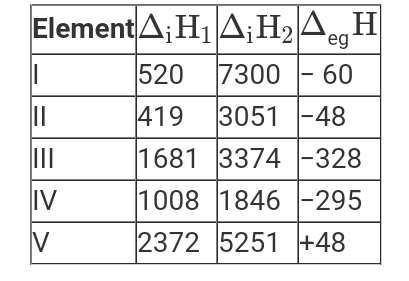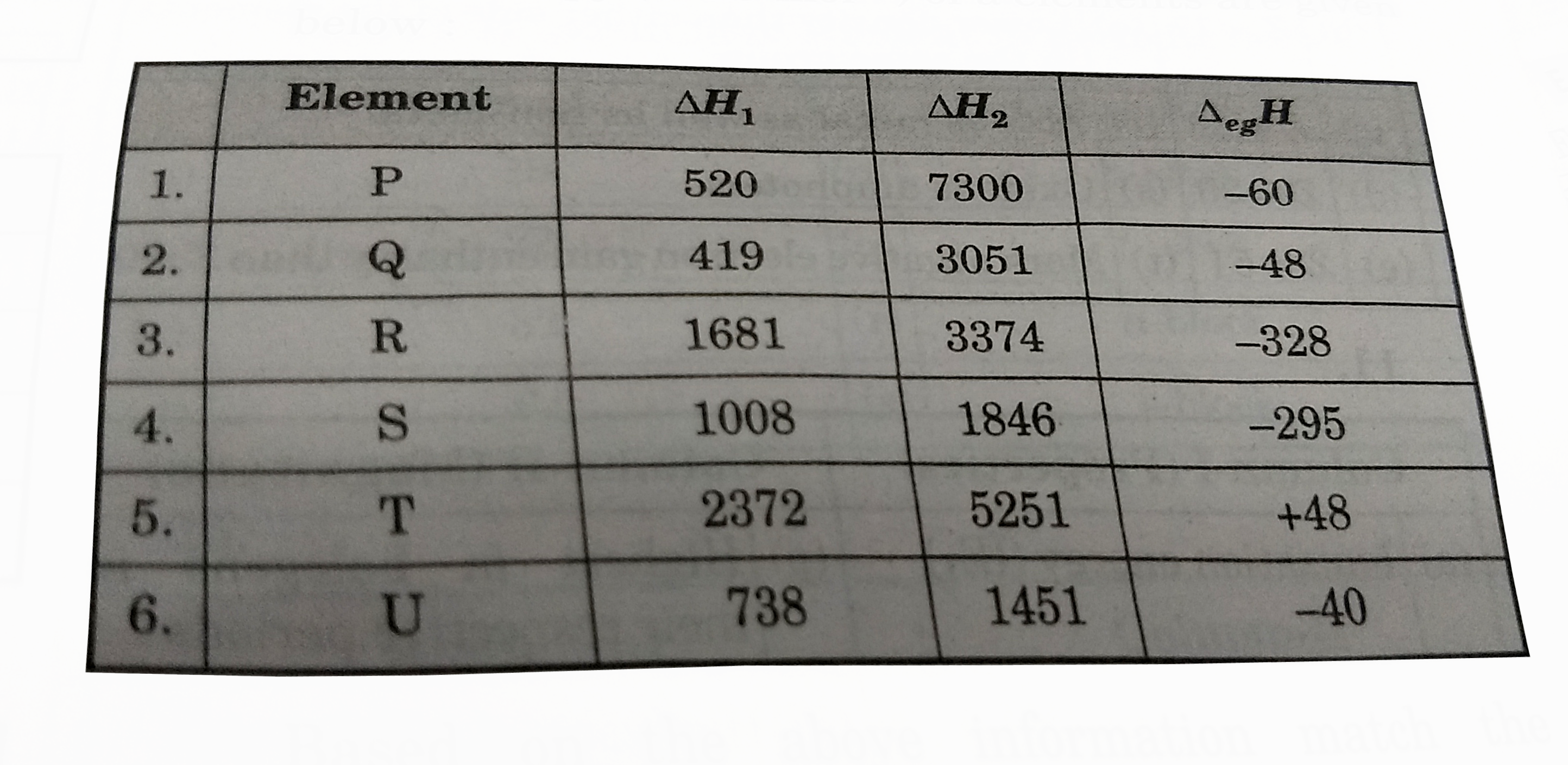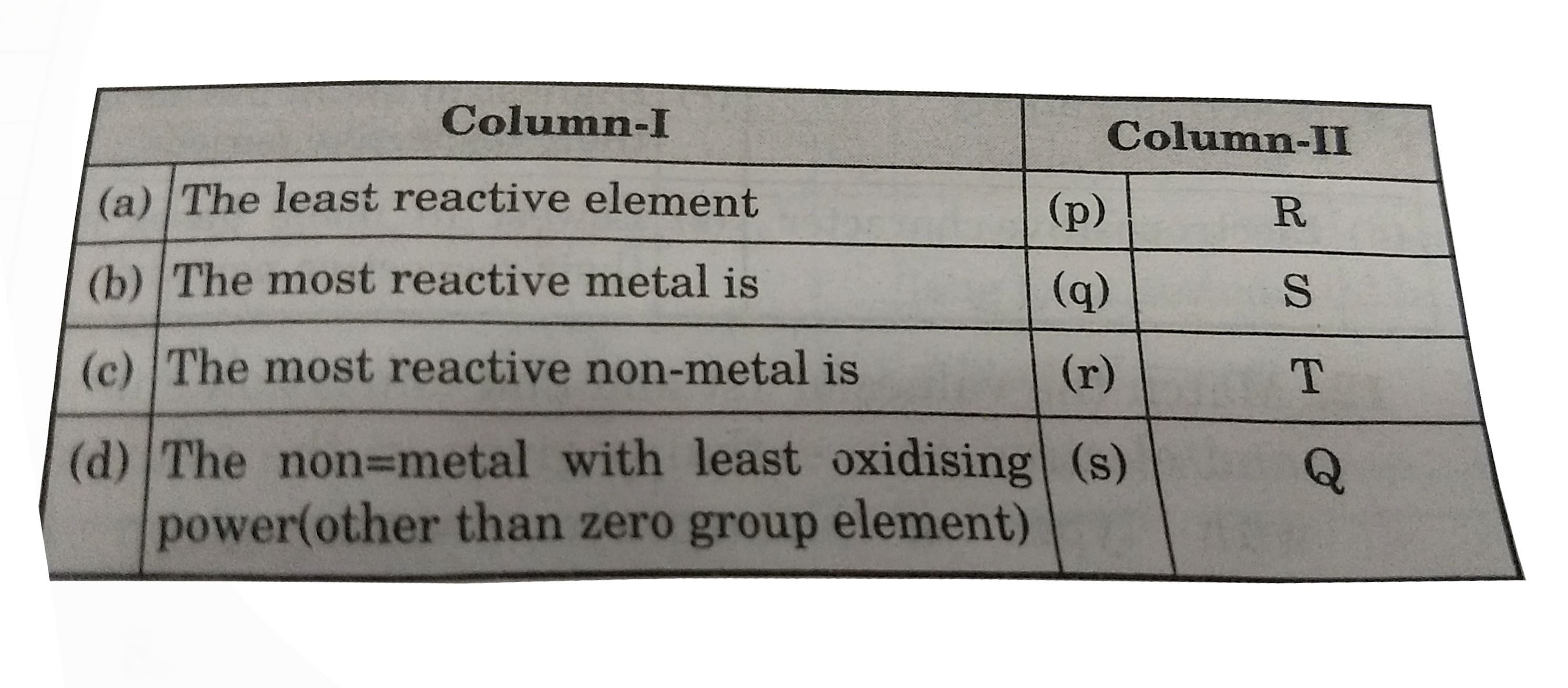The first (ΔiH1) and second (ΔiH2) ionization enthalpies (in kJ mol−1) and the electron gain enthalpy (ΔegH)(in kJ mol−1) of the elements I, II, III, IV and V are given below

the least reactive non - metal and the most reactive metal of these are respectively
I and V
V and II
II and V
IV and V
The correct Answer is:C
Element II : ΔiH1 is lowest and there is sudden jump between the values of ΔiH1andΔiH2 so its oxidation state is +1 and this element (metal) will be the most reactive metal.
Element V : The value of electron gain enthalpy (ΔegH) is positive. It means that energy is required to gain one electron.
Thus this non-metal will be the least reactive one.
Topper's Solved these Questions
- BOOK - ERRORLESSCHAPTER - CLASSFICATION OF ELEMENTS AND PERIODICITY IN PROPERTIES EXERCISE - NCERT BASED QUESTIONS (Electron Affinity)21videos
CLASSFICATION OF ELEMENTS AND PERIODICITY IN PROPERTIES
- BOOK - ERRORLESSCHAPTER - CLASSFICATION OF ELEMENTS AND PERIODICITY IN PROPERTIES EXERCISE - NCERT BASED QUESTIONS (Electronegativity)18videos
CLASSFICATION OF ELEMENTS AND PERIODICITY IN PROPERTIES
- BOOK - ERRORLESSCHAPTER - CLASSFICATION OF ELEMENTS AND PERIODICITY IN PROPERTIES EXERCISE - NCERT BASED QUESTIONS (Atomic and Ionic Radii)39videos
CLASSFICATION OF ELEMENTS AND PERIODICITY IN PROPERTIES
- BOOK - ERRORLESSCHAPTER - CHEMICAL EQUILIBRIUMEXERCISE - ASSERTION & REASON12videos
CHEMICAL EQUILIBRIUM
- BOOK - ERRORLESSCHAPTER - ENVIRONMENTAL CHEMISTRYEXERCISE - ASSERTION & REASON7videos
ENVIRONMENTAL CHEMISTRY
Similar Questions
The first (ΔH1) and second (ΔH2) ionisation enthalpies (in kJmol−1) and the (ΔHeg) electron gain enthalpy (in kJmol−1) of a elements are given below:

Based on the above information match the following columns.
 View Solution
View SolutionIonisation enthalpy (ΔiH kJ mol−1) for the elements of group 13 follows the order.
View Solution
Knowledge Check
- Question 1 - Select One
The first (ΔIH1) and second (ΔIH2) ionisation enthalpies (in kJ mol−1) and the (ΔegH) electron gain enthalpy (in kJ mol−1) of a few elements are given below:

The least reactive element is :APBQCRDT - Question 2 - Select One
Ionisation enthalpy (ΔiH kJ mol−1) for the elements of group 13 follows the order.
AB > Al > Ga > In > TlBB < Al < Ga < In < TlCB < Al > Ga < In > TlDB > Al < Ga > In < Tl - Question 3 - Select One
Ionisation enthalpy (ΔtHlinkJmol−1) for the elements of group-13 follows the order
AB>Al>Ga>In>TIBB<Al<Ga<In<TICB<Al>Ga<In>TIDB>Al<Ga>In<TI
The first (ΔiH1) and second (ΔiH2) ionisation enthalpies (inkJmol−1) and the (ΔegHө) electron gain enthalpy (inkJmol−1) of a few elements are given below:
Elements(ΔiH1)(ΔiH2)ΔegHөI5207300−60II4193051−48III16813374−328IV10081846−295V23725251+48VI7381451−40
Which of the above elements is likely to be
a. the least reactive element.
b. the most reactive metal.
c. the most reactive non-metal.
d. the least reactive non-metal.
e. the metal which can form a stable binary halide of the formula MX (X=halogen).
f. the metal which can form a predominantly stable covalent halide of the formula MX(X=halogen).View SolutionThe first (ΔiH1) and second (ΔiH2) ionisation enthalpies (inkJmol−1) and the (ΔegHө) electron gain enthalpy (inkJmol−1) of a few elements are given below:
Elements(ΔiH1)(ΔiH2)ΔegHөI5207300−60II4193051−48III16813374−328IV10081846−295V23725251+48VI7381451−40
Which of the above elements is likely to be
a. the least reactive element.
b. the most reactive metal.
c. the most reactive non-metal.
d. the least reactive non-metal.
e. the metal which can form a stable binary halide of the formula MX2 (X=halogen).
f. the metal which can form a predominantly stable covalent halide of the formula MX(X=halogen).View SolutionWhy do halogens have high electron gain enthalpies (i.e. −ΔegH⊙)?
View SolutionThe second electron gain enthalpies (in kJ mol−1) of oxygen and sulphur respectively are:
View SolutionThe first (ΔiH1 and second (ΔiH2 ionization enthalpies (in kJ/mol) and electron gain enthalpy (in kJ/mol) of few elements are given below:
ElementsΔiH1ΔiH2ΔegHI5207300−60II16813374−328III8991757+48IV23725251+48
Which of the above is likely to be He:View Solution

